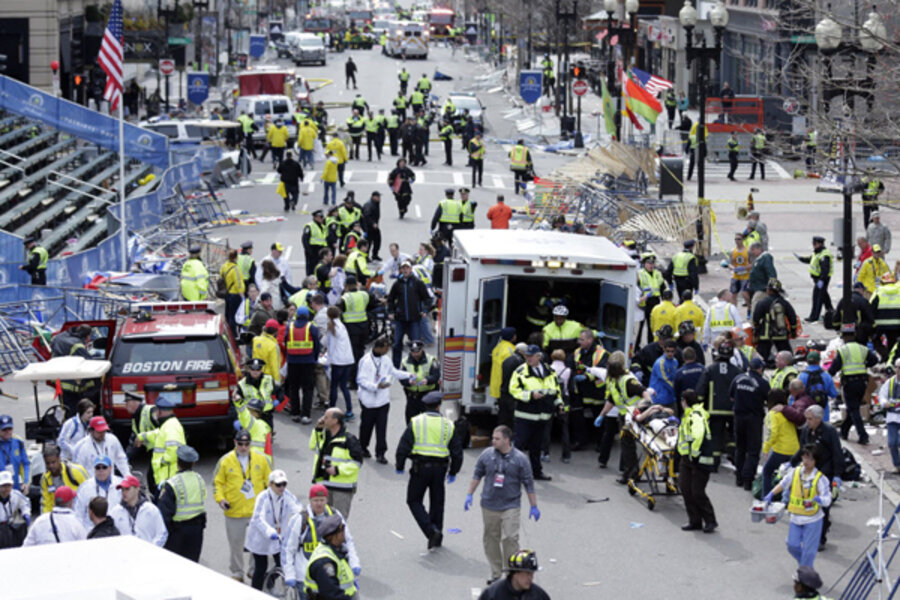Boston Marathon tragedy: 2 dead, at least 28 injured in back-to-back blasts
Loading...
| Boston
Two explosions near the finish line brought a tragic halt to the Boston Marathon Monday afternoon while the race was still in progress. A third explosion occurred some time later at the John F. Kennedy Presidential Library, about four miles from the scene in the Back Bay.
The blasts at the finish line rocked Boylston Street, killing at least two people and injuring at least two dozen others – some severely, according to news reports. That prompted a sudden end to the race as legions of runners were still trying to finish.
The first explosion, coming at 2:50 p.m., some three hours after the leading men and women had crossed the finish line, was followed quickly by a second blast 50 to 100 yards away.
At least one runner was knocked off his feet by the force of the blasts, which came very close to the finish line.
Officials said it's not clear if the explosion at the presidential library is related to the two at the marathon finish line.
Boston police and fire personnel, already assembled to provide race security and to address medical needs of the marathon runners, focused immediately on helping the injured and safeguarding the area against potential additional explosions.
Some eyewitness reports described one blast as coming up out of the sidewalk. The fact that there were two blasts, within seconds of each other, near the finish line led many analysts and witnesses to suspect an intentional attack to cause harm and disruption on what is usually one Boston’s biggest days of festivity each year.
No official statements had been made, as of 4:30 p.m., about the likely cause of the blasts, although The Associated Press is reporting that an unnamed federal intelligence official has characterized the explosions as bombs. The official also said two other explosive devices were found in the general vicinity of the other blasts and were being dismantled, according to AP.
The official said it was not clear what the motive was or who may have launched the attack.
As concern mounted that Boston may be the target of a terrorist attack, the state of alert in the nation's capital was heightened, including the notification of President Obama and Vice President Joe Biden.
“Apparently there has been a bombing … I’m looking at it on television now,” Mr. Biden said, interrupting some remarks he was making Monday afternoon.
New York also raised its alert level.
In Boston, responders focused on treating the injured, with some of them helped in a tent normally used to aid runners struggling with fatigue or dehydration.
Larry Guidetti, whose daughter was running in the marathon, says he was about 100 yards away from the first explosion when it happened.
"First of all, there was a huge explosion to the right, and then no more than 10 seconds later, there was another one on the left."
He said that, from his perspective, "it was definitely explosives.”
"The police acted very quick," said Mr. Guidetti. "Thank God there wasn't a big panic."
Mike Illobre, who was standing nearby on top of a generator box for a better view of the race, said the impact of the first explosion nearly knocked him off the box. He was not injured.
As authorities sought to seal off the area surrounding the blasts, a main artery of the subway system's Green Line was closed as a precaution. That stretch runs under Boylston Street in Boston's Back Bay section. The Lenox Hotel, which is across Boylston Street from the second blast, was evacuated. The Fairmont Copley Plaza, which served as the media hotel for the marathon, was put on lockdown, as well as Emerson College, which sprawls across several city blocks near Boston Common.
For runners who were a mile or more from the finish line, the explosions resulted in a period of confusion as they tried to finish the race. Some runners heard spectators yelling "check your phone," or saw people moving toward them on the course before hearing that police were ending the race
Spectators and businesses in the area had their own challenges. At an Apple store near the finish line, people in the store were ushered into a basement for about 10 minutes before being ushered out a back door away from where the explosions took place.
For those concerned about locating missing persons in Boston, try this Google link.
Correspondent Allison Terry and staff writer Whitney Eulich contributed to this report.







